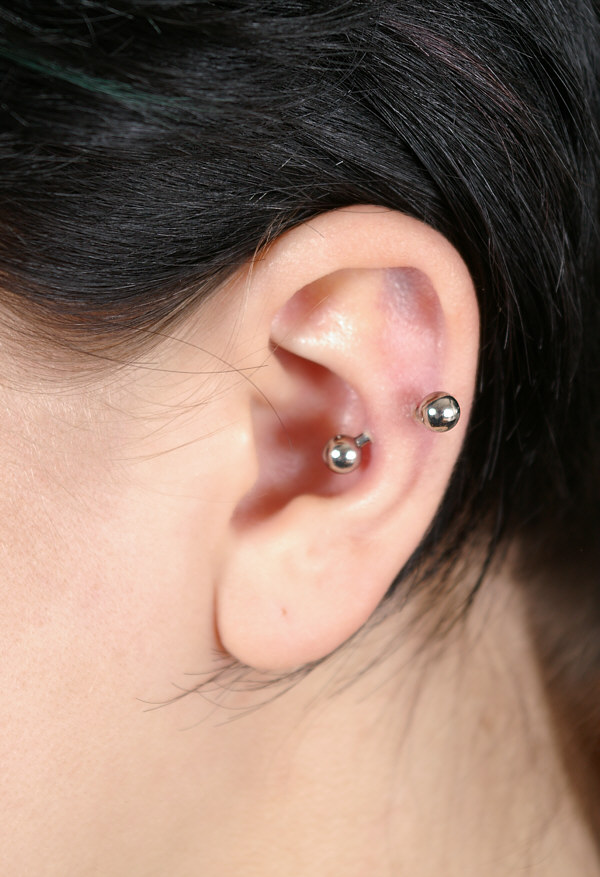Both, men and women across the globe are sporting new types of piercings, such as snug piercings. Not only are these piercings a great way to modify the ear, but they look extra fashionable. This piercing is located on the inner part of the ear; on the rim of the cartilage.
The snug area of the ear is found in the lower part the antihelix. The piercing passes through the medial to the lateral portions of the antihelix and not from front to back. Commonly, it is known as an antihelix piercing.
This kind of piercing was coined by Caitlin Theobald after her successful fashion clothing brand name Snug Industries back in the middle of the 1990’s.

HOW SNUG PIERCINGS ARE DONE?
The method by which this piercing is performed is fairly simple. However, there are two important criteria that need to be taken into consideration before a professional piercer performs a snug piercing.
First, there must be ample space on the ear cartilage to make this piercing possible. If there isn’t sufficient place then this piercing cannot be done. Secondly, the cartilage must be strong to allow the piercing to be performed. If the cartilage is not strong enough then the piercing is likely to be rejected.
Next, in order to do the piercing, the piercer will first clean the ear with a disinfectant to kill off any bacteria and dirt. This is a crucial step to prevent any infection. Thereafter the piercer will mark the location of the area of the snug to be pierced. Once the marking is complete a cannula needle is inserted in the snug area and the jewelry is inserted.
WHAT DOES SNUG PIERCING JEWELRY LOOK LIKE?
A straight or curved barbell is the most recommended first piercing jewelry. The jewelry must be of 18 gauge to 14 gauge of thickness and a length of 8 to 10 mm. After the wound has healed, you can use a ball closure ring, circular rings or horseshoe circular barbells.
A stud similar to the piece used in earlobes can be used for a standard helix piercing. Titanium or surgical steel jewelry is used because it is the least reactive metal and it usually has a very tight back to hold the jewelry in place.
Some people may be fascinated by the snug piercing but are uncertain to try the real one. For a more fashionable look without the discomfort of a long healing process, they can use a faux snug piercing. It is done with two separate piercings that appear to be snug piercing.
WHEN CAN THE JEWELRY BE CHANGED?
It can be extremely tempting to change the jewelry in the early days; however, this should not be done. Reason being that the snug piercing is highly unlikely to have healed within the first few months. It’s best to wait until you entirely sure that the piercing has healed before changing any jewelry.
The minimum estimated time for changing jewelry is six months. Always be certain that the piercing is completely healed before changing it. Failure to do so could cause discomfort, irritation and even infection.
COST OF A SNUG PIERCING
Price of snug piercings varies in different parts of the world. In the US, it will cost anywhere between $30-$70 and this will include jewelry. If you’re in the UK, you will roughly pay between £25-£50.
When choosing a piercing parlor it might be tempting to go for the cheapest option. However, always ensure that the parlor you choose to go to is a reputable place. Check out a few reviews beforehand and ask around to be completely sure.

DOES A SNUG PIERCING HURT?
It is always a question of how much pain your body can tolerate. The pain and discomfort experienced during healing can last for quite some time because this part of the ear is extremely sensitive. With that being said, it should be noted that the Antihelix has thick cartilage on it so piercing it can be rather painful.
Bottom line is that this piercing will hurt and pain medication can be taken for those who have a low tolerance level to pain.
HEALING TIME
Snug piercing takes longer to heal because it is done on a cartilage. The cartilage does not have enough blood supply which makes healing time longer. Complete healing can occur between three to nine months.
Snug piercing is considered to be the most difficult ear piercing to heal without any issues. Swelling, redness, discomfort, tiredness, and itching can happen during the healing process.
HOW TO CARE FOR YOUR SNUG PIERCING?
After getting a snug piercing aftercare is very important and could affect healing. In order to ensure a smooth recovery, these are the things that need to be done. These things can prevent infection and speed up healing time.
- Always ensure that your hands are washed with antibacterial soap before you touch your piercing. Often we don’t realize just how much of germs we carry around, and the last thing you want is for any germs getting into your piercing.
- Gently clean the piercing with warm water and a q tip to ensure that all dirt is removed. This should be done twice a day, every day until the piercing is fully healed.
- After cleaning the area pat dry with a clean washcloth so that there isn’t any moisture left over.
- If you have long hair keep your hair tied up to avoid it from getting tangled in the jewelry. This can easily cause unnecessary irritation.
- While the piercing is healing it is highly sensitive, and for this reason, it’s best to avoid sleeping on a new snug piercing.
- Avoid swimming or sharing personal liquid items to prevent infection.
- Do not scratch, pick, play, rub or remove your new piercing jewelry. This will delay recovery and might affect the healing.
- Do not use cream, peroxide or ointment especially those used by another person. This may lead to infection, swelling and prolong the healing.
- If anything seems wrong, call your professional piercer for advice.
- Purchase the correct aftercare products.
WHAT AFTERCARE PRODUCTS SHOULD YOU GET
When looking for aftercare products, look out for natural products that work on all skin types. Ideally, you will need a product that removes dried discharge and any lymph secretion. Sea salt products are rated as one of the best to use on healing piercings.
Also, look out for products that have anti-inflammatory and anti-bacterial properties. These work wonderfully on healing piercings because the help keeps the area clean.
IS THIS PIERCING FOR YOU?
If you’re someone who likes to piercings and someone who likes to try out new looks then definitely, yes. This piercing can help anyone attain a trendy look and doesn’t come with much effort.
However, if you’re someone who is afraid of change and afraid of pain then abstain from this piercing. It might end up being a complete nightmare if you’re unsure. Our advice would be to first try out some faux jewelry and see if you like the look of it. Weigh in the pros and cons and then decide if it’s something you actually want. This will allow you to evaluate what you’re looking for without any commitment and pain.